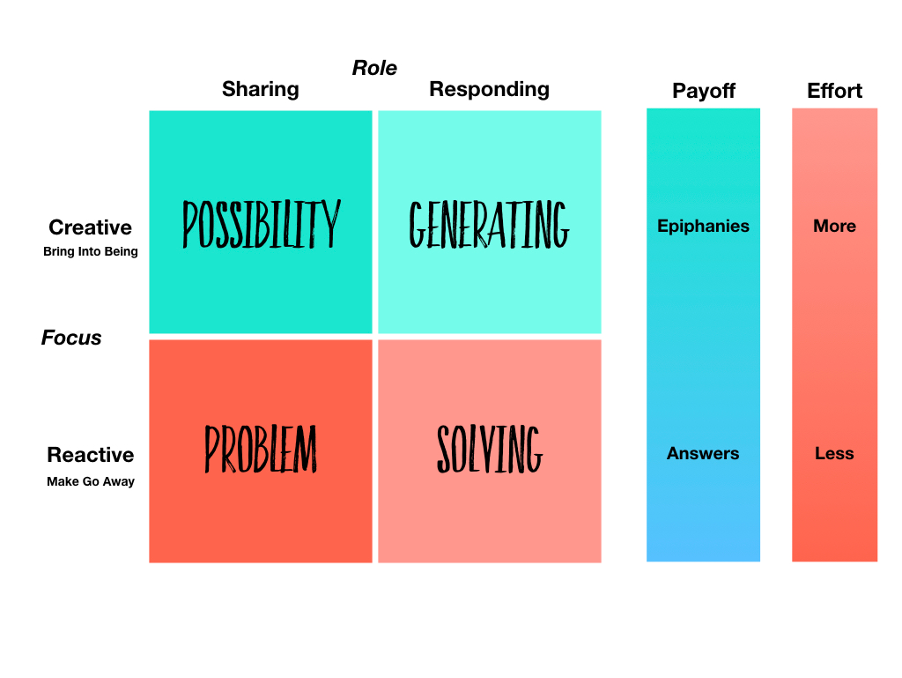Where’s Your Focus?
In my years of working with leaders in all sorts of settings, I’ve noticed that a conversation’s outcome depends very much on what the conversation is focused on.
Take Bruce, an under-pressure senior leader who’s leading a conversation with his management team that goes something like this:
“Our engagement scores tell us that we’re bad at managing poor performance. How do we fix that?”
“Well, we could get all the managers to do more performance management training and make it mandatory to have weekly one-on-ones.”
“OK let’s try that. That should fix it.”
Across town, Brent takes a different approach:
“Our engagement scores tell us that we’re bad at managing poor performance. What do we want to do about that?”
“Well, there’s always going to be that view from some people, because it’s done behind closed doors. What we actually want is a high-performing organisation, right? What would happen if we focused more on helping the large number of good people be even better, rather than putting a huge effort into trying to fix the relatively small number of poor performers?”
“The place would be buzzing and we’d be nailing it. Let’s make that happen!
The difference? Bruce’s team are focused on trying to make the problem go away. Brent’s team are focused on what they want to create more of.
There are two types of focus. Both are valid, and one is more powerful over the longer-term.
A ‘Problem’ Focus is when you focus on the challenges and issues right in front of you. “How can we influence those stakeholders who doesn’t seem to get it? “How can I find more time to think and reflect?” “How do we deal with those poor engagement scores?” In a ‘traffic light’ system these are the red numbers. They’re often pressing, important questions that take up attention and energy.
On the other hand, a ‘Possibility’ Focus is when you focus on what you want, not on what you don’t want. It’s about using what’s working well as a foundation for improvement. It’s about focusing more on creating more green traffic lights. It’s still about solving problems, but in a different way. It’s about vision and purpose first. The stuff of leadership.
In my experience, around 90% of conversations at work have a Problem Focus. That’s understandable. It’s easier to be here. Our brains love to solve problems. We get the satisfaction of discovering an answer, and that’s fun. When we solve a problem, we’ve made it go away, and we can get on with things. The pain disappears. At least temporarily. I call it the Panadol approach to workplace pain.
When your conversation has a Problem Focus, you’re spending your time and energy on diagnosis and solutioneering. You’ll no doubt get some answers. Have you ever thought that you might not have been asking the right questions
A Possibility Focus is different. It’s about first imagining a desirable future – what you want to create, and why you want it. Then strategising how you can make that happen. It’s harder work being here. As I’ve written about before[MOU1] , the hardest question in the world is “What do we want?” It requires you to bring something into being that might not even exist yet.
Here’s how those two ideas look together:
In times of deep uncertainty and change, simply making problems go away isn’t enough. ‘Back to normal’ is not an option when there is no normal. The people who thrive are the ones who decide what they want and move heaven and earth to make that happen. Right now, we need more people, and organisations, who think that way. Rather than taking a Panadol, do more of the stuff that keeps you well.
If you want to make change happen, a Possibility Focus is the platform from which your change-making happens. When we persevere with a Possibility Focus, the payoff can be game-changing epiphanies rather than merely answers to immediate problems.
It's not as binary as it sounds. Your conversations can include both elements. Here’s an approach to apply this thinking:
Begin by deciding on what outcomes you want to see. What does great look like?
Acknowledge and celebrate what’s going well. That’s your foundation for improving from.
Acknowledge what’s not going so well. No sense in ignoring it.
Explore what conditions create the good stuff. Look for common themes and patterns.
Determine what you might want to do to keep the good stuff going.
Look for ways to create those conditions where the results are not so good.
Come up with some simple experiments and try them.
These ideas have been outlined in way more depth in books like Switch by Chip and Dan Heath, and in the Appreciative Inquiry method. Nonetheless, they’re way less common in practice. What will you do to bring a Possibility Focus into your world?


